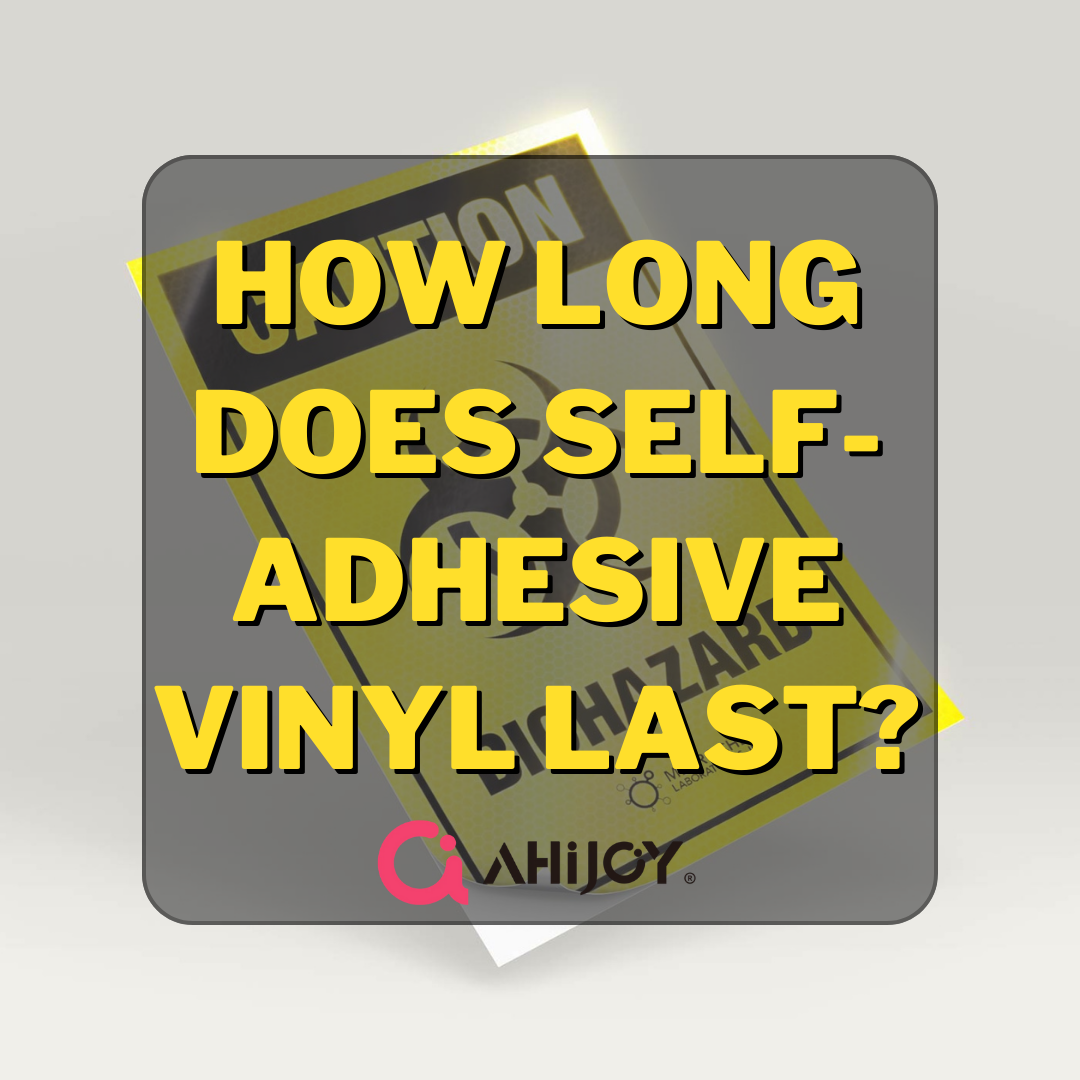posted by Ahijoy on September 20, 2022
Best Fabric For Heat Transfer Vinyl
For crafters who love to work with fabric, heat transfer vinyl is a dream come true. It offers so many different ways to embellish one’s garment and unleash one’s creativity. A special vinyl polymer, HTV, is used to decorate apparel with customized designs. It has an adhesive backing that is activated when a heat source is applied to it. It is available in many different colors and textures giving you multifarious options to personalize your product, flaunt it and earn praise for your workmanship.

How Is HTV Used?
HTV is used on fabrics, especially cotton, polyester, poly/cotton blends and the like. Hence you can create custom shirts, t-shirts, bags, shoes, home decor items and more.
HTV needs a heat source to transfer the vinyl onto a fabric. Heat can be applied through a dry iron used at home or an automated heat press machine. Different vinyl are set at different temperatures and pressure settings. Once it has transferred, it transforms the substrate into an exquisite piece worth accolades.
The Right Fabric
In order to get the best possible result, it is imperative to use the right fabric. If care is not taken, the HTV will not paste properly resulting in a wasted effort. Following is the detail of which fabric to use with HTV:

Can You Use HTV On Polyester?
Polyester
Polyester is frequently used in heat transfer vinyl projects because it has a smooth surface that allows the HTV to adhere easily without peeling off after printing. It also withstands repeated washing without losing its color or shape over time.
This makes polyester a great choice for projects that will see regular wear and tear like sports jerseys and t-shirts, but it's also great for accessories like hats if they're going to be used outdoors often since they're more durable than cotton fabrics.
Instructions:
- Polyester cannot withstand high heat so keep the temperature lower than 300°F. Preferably 270°F. High temperature will lead to scorching of the fabric.
- Apply light pressure.
- Apply for 10-12 seconds.
- Peel the transfer while it is still warm.

Cotton
Cotton is another popular fabric choice for HTV because of its breathable nature and natural comfort factor. Cotton can be used for just about anything from t-shirts to tablecloths, pillowcases and more, but keep in mind that it won't hold up against frequent outdoor use as well as polyester will.
Instructions:
- Heat the press to 320°F.
- Make sure the product is evenly pressured.
- Smooth wrinkles by pressing the garment.
- Put the design in the right place.
- Hold for 12-15 seconds.
- While it's still hot, peel the transfer.
Canvas
Canvas is one of the best fabrics to use for heat transfer vinyl. High temperatures can be tolerated and it is durable. You can also paint on it, which is an added benefit if you want to design your own shirts or other clothing items. Canvas shoes can be designed with HTV giving them a new and unique look.
Instructions:
- The temperature for canvas should be 305°F.
- Press for about 20 seconds.
- Apply medium pressure.
- Peel the transfer after the design has cooled down.
Denim
Denim is another popular choice for heat transfer vinyl because it has a nice, rough texture that makes it feel like real denim clothing. The material also works well with all kinds of designs and colors, making it an excellent choice for many projects. You can easily add bling to your most comfy jeans or an exquisite design that no one has ever seen with HTV. Denim bags can also be customized.

Instructions:
- The temperature for denim should be 300°F - 315°F.
- Press for about 10-15 seconds.
- Apply moderate pressure.
- Peel the transfer hot.
Silk and Satin
Silk and satin are other good options for embellishing with HTV. You can add your name to that beautiful satin robe or a delicate flower motif to your silk scarf. HTV will work better if it is 100% pure silk. Since it is a heat sensitive fabric, you will have to set a lower temperature to apply HTV to it.
Instructions:
- For silk and satin the temperature should be low around 270°F to 280°F..
- Press for 15 to 20 seconds.
- Apply firm, medium pressure.
- Peel the transfer warm.
Burlap
Burlap is a material with a rough or a coarse texture. It is made from natural plant fibers. HTV can be applied to burlap but it’s a bit of a tricky substrate due to its natural, uneven surface. It comes in both loose and tight weave. Loose weave has tiny gaps in between so it is recommended not to use HTV on it. Tight weave burlap, however, is a favorable option. The only hitch is its uneven texture.
Instructions:
- For burlap the temperature should be low around 305°F to 325°F..
- Press for 20 seconds.
- Apply firm, medium to high pressure.
- Peel the transfer warm.

Tips On Using Heat Press
- Do not use 100% polyester with heat transfer vinyl. The results will be poor if you use heat transfer vinyl on 100% polyester. This type of material tends to stretch when heated up, which can cause the design to distort or rip off entirely. Stick with blends that contain spandex.
- If your garment has lint or other particles on it, use a lint roller to get rid of them as they can end up trapped in the HTV after it's applied. This could cause snags and tears once the item is worn repeatedly over time. To avoid this problem, use a lint roller prior to applying your HTV design!
- Do not pre-wash your fabric. If you pre-wash it before applying your HTV, the material around the printed area will stretch out and look distorted when washed again later.
- The first thing to consider is how long you should press your heat transfer vinyl onto the garment. With a basic iron, you will need to press for a longer period of time. This is because polyester has a lower melting temperature than cotton, which means it will take longer for your iron to melt through the material.
- Another important tip when using HTV is preheating your material before pressing it with your iron. This will ensure that there are no creases or moisture on the surface of the substrate.
- An important step is to test your fabric, especially if it’s a new product or one that you haven’t used before. You can do this in a couple of ways. The first step is to test it inconspicuously. If there are no adverse reactions, it should be okay to use the full design across the whole shirt.
- Silicone sheets are commonly used when applying heat transfer vinyl to cotton t-shirts because they help keep wrinkles away from your design as well as provide a smooth application surface for your heat press. While silicone sheets can be used on polyesters as well, they do not work very well on them because they can cause creases in the design that will become permanent once cooled down again (this is specifically true if you use an iron or ironing board).

Can you use an iron instead of a heat press?
Heat Press vs Iron
Heat transfer vinyl is best applied with a heat press instead of an iron. The reason for this is when the material gets too hot from an iron, it may start melting and ruining your design before it even comes into contact with the hottest part of the press.
This can happen especially if you get too close when ironing small details such as text or logos on clothing items like shirts or hats where there isn’t much room between the transfer design and your iron. If you use a heat press instead, it will allow you more control over how much pressure is being applied to each piece of clothing.

Frequently Asked Questions
Conclusion
We hope that this has answered your question about the best fabric for heat transfer vinyl. You won't be able to remove vinyl effectively from corduroy or velvet when heat stamping. If you want to be on the safe side and get perfect results each time, stick to cotton when using HTV. Happy crafting!



